Kings Nympton railway station
Kings Nympton railway station, also known as King's Nympton,[lower-alpha 1] is a halt on the Tarka Line in North Devon, serving the civil parishes of Chulmleigh, Burrington and King's Nympton. Despite its name, Kings Nympton railway station is around 2½ miles (4 km) from King's Nympton—the station is located at Fortescue Cross, a road junction between the A377 and B3226 in the civil parish of Chulmleigh,[1] roughly equidistant between the hamlets of Head Bridge and Colleton Mills around a mile (1.6 km) to the north and south. The station is operated by GWR, who run six northbound trains a day from Kings Nympton to Barnstaple, and five southbound trains a day to St James Park via Exeter St Davids.
 | |
| Location | Chulmleigh, North Devon England |
| Coordinates | 50.93600°N 3.90535°W |
| Grid reference | SS662169 |
| Managed by | Great Western Railway |
| Platforms | 1 |
| Other information | |
| Station code | KGN |
| Classification | DfT category F2 |
| History | |
| Original company | North Devon Railway |
| Pre-grouping | London and South Western Railway |
| Post-grouping | Southern Railway |
| Key dates | |
| Opened | 1854 |
| Passengers | |
| 2015/16 | |
| 2016/17 | |
| 2017/18 | |
| 2018/19 | |
| 2019/20 | |
| Notes | |
Passenger statistics from the Office of Rail and Road | |
The North Devon Railway opened Kings Nympton station as South Molton Road, referring to the B3226, in summer 1854. The North Devon Railway was taken over by the London and South Western Railway in 1865; the LSWR was amalgamated with other railways to create the Southern Railway at the start of 1923; the Southern Railway was nationalised in 1948, becoming the Southern Region of British Railways. The British Railways Board renamed the station to Kings Nympton in 1951; transferred it back and forth between the Southern and Western Regions; and then recommended in the 1963 Beeching report that it be closed. The station did escape closure but ended up in the Western Region and subsequently fell into decline, with British Rail reducing it to a single track and platform and closing the station hotel, which had provided refreshments and public conveniences. Since privatisation in 1996, the station has been operated by Wales & West, Wessex Trains, First Great Western and, since 2015, GWR.
Apostrophe in name

Usage varies on whether the station's name is King's Nympton, the same as the nearby village, or Kings Nympton, without the possessive apostrophe.
The Rail Delivery Group (RDG) spells the name without an apostrophe,[2] and so this spelling is used in journey planners and station databases which use RDG data, including those of National Rail,[2] the Train Operating Companies (TOCs),[3][4][5][6][7] and Trainline.[8] The TOC that operates the station, GWR, uses the non-apostrophe variant in contexts where it and not the RDG determine the spelling, including on station signage and in timetables.[9] Google Maps and Wikipedia both also omit the apostrophe.
On the other hand, the 1963 British Railways Board report The Reshaping of British Railways—the Beeching report—uses the spelling King's Nympton in the list of stations to be closed.[10] Ordinance Survey currently uses the apostrophe,[11] as does The Guardian,[12] though it is not considered an authority on railway spelling.
BBC News use both spellings inconsistently,[13][14] as do the Tarka Rail Association.[15]
History
Opening

The station was ceremonially opened as South Molton Road on 12 July 1854, one of the nine stations on the original North Devon Railway (NDR) line between Barnstaple and Crediton (from whence NDR trains continued on the Exeter and Crediton Railway to Exeter St Davids). The station name referred to the road now called the B3226, which at the time was called the "South Molton Road"; it was not supposed to imply proximity to the town of South Molton, which was around 9 miles (14.5 km) away and closer to Portsmouth Arms one stop down the line.[lower-alpha 2] Along with the rest of the NDR, South Molton Road was subsequently opened to the public on 1 August, with a service of four trains a day in each direction from Monday to Friday and two trains a day on Sundays.[16]
LSWR and Southern Railway
The LSWR built a 16-lever signalbox at the station. At this time, there were also three sidings at South Molton Road, two accessed from the down loop, and one from the up loop, and a one wagon bay off one of the sidings on the up side. During the 1870s, the station was at least sometimes referred to with the variant name "Southmolton Road".[17][18]
The station master at South Molton Road in 1879 was a Thomas Lock.[17][lower-alpha 3]
The Railways Act 1921 merged the LSWR with other railways to create the new Southern Railway. Along with the Exeter to Plymouth railway of the LSWR, the North Devon Line was part of the "Withered Arm" of Southern routes in predominantly Great Western Railway territory. By 1938, South Molton Road was served by eight trains a day in each direction.[19]
Decline under British Rail

The Southern Railway was nationalised in 1948 and South Molton Road became part of the Southern Region. In 1951, British Rail renamed the station to its current name, both to avoid confusion with South Molton railway station on the Barnstaple–Taunton line and to better reflect the area actually served by the station. The British Railways Board (BRB) transferred the "Withered Arm" lines, including the North Devon Line, from the Southern Region to the Western Region in 1950. However, despite the infrastructure now being the responsibility of the Western Region, it was the Southern Region that continued to operate trains; as such, from 1950, Kings Nympton was a Western Region station served exclusively by Southern Region trains.[20] The BRB transferred the North Devon Line back to the Southern Region in 1958. In 1963, the BRB report The Reshaping of British Railways—the Beeching report—included Kings Nympton on the list of stations to be closed, along with the rest of the North Devon Line.[10] The proposal was not acted on and the station escaped the Beeching axe, though, in the same year as the Beeching report recommended its closure, the BRB again transferred the North Devon Line to the Western Region.[20]
After 1963, the Western Region downgraded lines and cut services across the former LSWR lines now under their control.[20] Kings Nympton did not escape such treatment, and despite narrowly escaping the Beeching axe, under British Railways (from 1965, British Rail) it fell into decline. In both 1955 and 1969,[21][22] the station had two platforms; the LSWR signalbox; semaphore signals; and the Fortescue Arms hotel, which provided public conveniences and refreshments at the station;[15] In summer 1970, the LSWR signalbox was taken out of use and demolished; the current no-signaller token remote working was introduced in December 1987.[23] The southbound platform was at some time closed as well, though one siding, accessed via a groundframe, was retained for a number of years, handling fertiliser traffic.[24] The Fortescue Arms hotel was still open in January 1983, when the Tiverton Staghounds met there for hindhunting.[25]
From privatisation to GWR
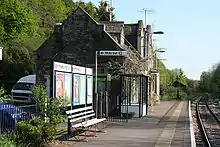
British Rail was privatised in 1996, and on 13 October, the North Devon Line was taken over by Wales & West, controlled by Prism Rail. The station itself was transferred to Railtrack, which later became Network Rail, but continued to be operated by whichever TOC ran the line. National Express purchased Wales & West from Prism Rail in July 2000, and in October 2001 rebranded Wales & West as Wessex Trains after the Strategic Rail Authority transferred the company's Welsh services to Wales and Borders. Wessex Trains introduced the name "Tarka Line" and started running a service of Class 143 Pacers, Class 150 Sprinters and Class 153 Super Sprinters, with direct services from Kings Nympton to Barnstaple and Exmouth.
Wessex Trains gave way to First Great Western (FGW) in 2006. FGW installed new signage at Kings Nympton, with black Rail Alphabet text on a white background. This was the British Rail standard introduced in 1965 and was used after privatisation by Arriva Trains Wales until 2018 and FGW until 2015.[26] FGW also continued using the "Tarka Line" branding introduced by Wessex.
In February 2012, the North Devon Public Transport Users' Group proposed that Kings Nympton—along with every other Tarka Line station except for Barnstaple, Crediton and Exeter St Davids—be closed, to improve journey times between Exeter and Barnstaple.[13] The suggestion was opposed by the Tarka Rail Association, who said that the group "cannot ignore the importance of those communities" served by Tarka Line halts like Kings Nympton, and Network Rail took no action on the basis of it.
In September 2013, the Tarka Rail Association published their Strategy for the Exeter–Barnstaple Line, laying out their aspirations for improvements to the Tarka Line.[27] These included work to prevent flooding at Kings Nympton,[27] and a recommendation that the track be moved back and the platform widened.[27]
GWR since 2015

FGW rebranded as GWR in 2015. The temporary signage at the station—timetable posters, etc.—were updated to reflect the new branding, but as of 2020, the permanent signage continues to use the FGW logo BR-style design. GWR also painted new yellow lines on the platform and installed a customer help point.
The station was closed for two weeks between 26 October and 8 November 2019 whilst works were carried out elsewhere on the Tarka Line,[28] in preparation for the extensive December 2019 timetable changes. These changes arrived on 31 December. The Class 143s and 153s were withdrawn and replaced with Class 158 Express Sprinters; at the request of the Tarka Rail Association, an additional northbound train from Kings Nympton was provided on Fridays; and direct services to Exmouth were withdrawn, with all southbound trains now terminating at St James Park.[29][9]
It was closed again between 30 March and 4 April 2020 so that Network Rail could lay new ballast and improve track drainage in the general area of the station,[30][1] implementing the suggestions made in the Tarka Rail Association's 2013 report.
Accidents and incidents
In October 2012, a driver crashed into an embankment close to Kings Nympton, causing a train to have to stop. The driver was critically injured and was airlifted out by the Devon Air Ambulance; three other casualties were treated at the scene. Trains were initially suspended and were subsequently only allowed to pass Kings Nympton at 5 mph.[14]
In September 2020, northbound trains were suspended through Kings Nympton, terminating one stop to the south at Eggesford, after a person was spotted "in the water"—presumably the River Taw, which runs close to the station.[31]
Description
Station facilities
Kings Nympton has car and bicycle parking space, customer help points, a bench, a waiting shelter with no seating, and a telephone box. The bicycle parking facilities are two Sheffield stands, allowing four bicycles to be stored at once, and the car parking is a concrete square with six unmarked spaces.[2] There is also a public litter bin, and towards the north end of the platform, a grit bin.[32]
The station has no ticketing facilities, public conveniences, cashpoint, refreshments, or waiting rooms.[2] As the platforms are at street level, the station is described in station databases as having "step-free access", though neither ramps for access to the train nor staff assistance are available for passengers in wheelchairs.[2]
Layout
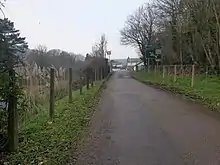
Kings Nympton has a single platform on the east side of the line. The platform is at a somewhat lower elevation than the main road and is reached via a gently sloped access road that runs to the car park, separated from the platform by a fence. The car park and platform are connected via a gate and the access road runs north from the car park alongside the A377 for around 100 yds (91.5 m) before merging into it about 80 yds (73 m) south of Fortescue Cross. Facing the line, the telephone box is in the car park to the left of the platform gate; the bicycle parking rack and the station information posters are to the right. On the platform, the shelter, litter bin and customer help point are on the left, the bench and station information posters are on the right, and the grit bit is some distance down the platform.
At the south end of the platform, there is a private house that still appears to be a former station building. Historically, this building was the station hotel,[21] the Fortescue Arms.[15]
Passenger volume
Kings Nympton is a fairly quiet station; in 2018–19, it was ranked 2,405th in the UK for entries and exits out of 2,566 stations, making it the 162nd least-used station. Of the thirteen Tarka Line stations, it is the fifth-least used, busier than Newton St Cyres, Lapford, Portsmouth Arms and Chapelton. Passenger numbers declined from around 7,000 entries and exits per annum in the late 1990s to a low of around 1,000 in 2006–07 and 2007–08, before rising again to a new high-water mark of around 8,000 in 2016–17 and subsequently entering a slower decline through the late 2010s, falling to around 5,000 entries and exits in 2018–19.
| 1997-98 | 1998-99 | 1999-2000 | 2000-01 | 2001-02 | 2002-03 | 2004-05 | 2005-06 | 2006-07 | 2007-08 | 2008-09 | 2009-10 | 2010-11 | 2011-12 | 2012-13 | 2013-14 | 2014-15 | 2015-16 | 2016-17 | 2017-18 | 2018-19 | |
|---|---|---|---|---|---|---|---|---|---|---|---|---|---|---|---|---|---|---|---|---|---|
| Entries | 771 | 992 | 1,289 | 1,503 | 2,241 | 1,874 | 2,879 | — | — | — | |||||||||||
| Exits | 771 | 992 | 1,289 | 1,503 | 2,241 | 1,874 | 2,879 | — | — | — | |||||||||||
| Total | 6,875 | 7,131 | 4,669 | 4,476 | 4,220 | 4,013 | 2,400 | 1,781 | 1,009 | 1,033 | 1,542 | 1,984 | 2,578 | 3,006 | 4,482 | 3,748 | 3,422 | 5,758 | 8,030 | 6,640 | 5,000 |
| The empty spaces show data that has been published by the ORR but has not yet been retrieved for this article. | |||||||||||||||||||||
The Department for Transport considers Kings Nympton a "small unstaffed" station with fewer than 100,000 journeys per annum, category F2.[34]
Services
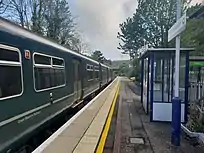
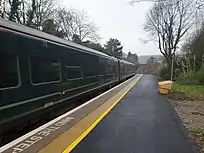
In the 14 September to 12 December 2020 timetable, Kings Nympton has six northbound trains to Barnstaple from Monday to Thursday, seven on Fridays, six on Saturdays and four on Sundays; and it has five southbound trains to Exeter (St James Park via Exeter St Davids) from Monday to Saturday, and four on Sundays.[9] As the station is a halt, referred to in modern public communications as a "request stop",[2][9] all services are scheduled to stop only on request—this means that passengers intending to alight at the station must alert the guard on the train, and passengers intending to board the train must signal to the driver from the platform.
The station is served by Class 150 Sprinters and Class 158 Super Sprinters.
| Preceding station | Following station | |||
|---|---|---|---|---|
| Eggesford | Great Western Railway Tarka Line |
Portsmouth Arms | ||
Location and local connections
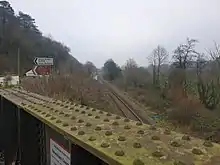
Kings Nympton is located at Fortescue Cross, a road junction and small cluster of houses in the civil parish of Chulmleigh. The road junction is between the A377 road, which largely runs alongside the Tarka Line between Barnstaple and Exeter, and the B3226, which runs to South Molton around 9 miles (14.5 km) away. Just north of the junction and the railway station, the A377 crosses the railway line on Newnham Overbridge. Kings Nympton station is over a mile away from any named settlement; the closest hamlets are Head Bridge and Colleton Mills, around a mile (1.6 km) to the north and south respectively along the A377.
The station serves the civil parishes of Chulmleigh, Burrington and King's Nympton, the villages of which are situated to the south-east, west and north-east respectively. By road, the station is approximately 2½ miles (4 km) from Chulmleigh via the A377 and the unnamed Chulmleigh–Colleton Mill road, 2½ miles (4 km) from Burrington via the A377 and Twitchen Lane, and 2½ miles (4 km) from King's Nympton via the B3226 and Kingsnympton Road. It is also close to Newnham, Elstone and Cadbury Barton, all of which are in the civil parish of Chulmleigh.
Bus services
Kings Nympton is associated with a bus stop named "Railway Station" at Fortescue Cross, around two minutes' walk from the platform, operated by Country Bus Devon. Railway Station bus stop is served by the 325 bus from Lapford to Barnstaple and the 663 bus from Chulmleigh to South Molton. One bus in each direction is provided each day.[35][36]
Culture
In 1983, American author Paul Theroux described the station name Kings Nympton—along with those of Eggesford and Yeoford—as a "Bertie Wooster touch" that contributed to the Tarka Line's "comic feel". More broadly, he described the branch line as a whole as "motionless and silent", characterised by "long low hills and withered villages", and stated that the interest of railway enthusiasts therein was "worse than indecent and their joy-riding a mild form of necrophilia."[37]
After complimenting other Tarka Line stations, Britain from the Rails: A Window Gazer's Guide says "whereas Kings Nympton is, frankly, in the middle of nowhere." It also refers to its name as "the ultimate cheek in station misnaming", and notes that "South Molton Road" was even more misleading, characterising it as "a hopeless attempt to trick people heading for that village, nine miles away on a rival line!"[38]
Notes and references
Notes
- Kings Nympton is used on the station signs and by the RDG, National Rail, TOCs, Google Maps and Wikipedia. King's Nympton is used by the former British Railways Board, Ordnance Survey and the Guardian. The Tarka Rail Association and BBC News each use both.
- It also had nothing to do with the historical station-naming convention of using "Road" as a suffix for partial proximity, as "Parkway" is used now; this was a Great Western Railway practice and the North Devon Railway was allied to the LSWR.
- To be precise, the entry in White's Directory reads "Lock Thos., L. & S.W. station mstr. Southmolton Road statn". Thos. is an archaic abbreviation of Thomas.
References
- "Improving the Tarka line". GWR.com. Great Western Railway. Retrieved 5 October 2020.
- "Station facilities for Kings Nympton". National Rail Enquiries. National Rail (a trading name of the Rail Delivery Group). Retrieved 5 October 2020.
- "Kings Nympton Train Station". South Western Railway. South Western Railway. Retrieved 5 October 2020.
- "Kings Nympton". Southern. Govia Thameslink Railway. Retrieved 5 October 2020.
- "Kings Nympton Train Station". Southeastern. London & South Eastern Railway Limited. Retrieved 5 October 2020.
- "Kings Nympton". CrossCountry. Arriva CrossCountry. Retrieved 5 October 2020.
- "Kings Nympton". Avanti West Coast. Avanti West Coast. Retrieved 5 October 2020.
- "Trains to Kings Nympton". Trainline. Retrieved 5 October 2020.
- "D2 Train times" (PDF). Great Western Railway.
- Beeching, Richard (1963). The Reshaping of British Railways (First ed.). London: Her Majesty's Stationery Office. p. 115.
- https://getoutside.ordnancesurvey.co.uk/local/kings-nympton-railway-station-north-devon
- Rushby, Kevin (29 March 2020). "10 UK Cottages to book now … for a stay later this year". The Guardian. Retrieved 5 October 2020.
- "Call for Devon Tarka Line stations to be closed". BBC News. Retrieved 5 October 2020.
- "Driver hurt in embankment crash in Devon". BBC News. British Broadcasting Corporation. Retrieved 9 October 2020.
- Phillips, John. "Kings Nympton". Tarka Rail Association. Tarka Rail Association. Retrieved 5 October 2020.
- Nicholas, John (1992). The North Devon Line. Sparkford: Oxford Publishing Company. ISBN 0-86093-461-6.
- White, William (1879). History, Gazetteer and Directory of the County of Devon: Including the City of Exeter, and Comprising a General Survey of the County. Devon: William White of Sheffield. p. 220.
- Tugwell, George (1877). The north Devon hand book. Oxford: Marshall Simpkin. p. 9.
- Bradshaw's Railway Guide for July 1938 (Reprint ed.). Newton Abbot: David and Charles. 1968.
- "British Railways Regional Structure 1948-1991". Southern Railway Research Group. Southern Railway E-mail Group. Retrieved 10 October 2020.
- Cullum, Dennis. British Railways Station View at Kings Nympton in 1955 [photograph]. The Transport Library. Accessed 9 October 2020.
- See photo right for 1969.
- NSTR Signalling http://www.railsigns.co.uk; retrieved 2009-03-04
- "UK lines that could reopen - the Tarka Line". the Railway Reinstatement Association. the Railway Reinstatement Association. Retrieved 9 October 2020.
- Huskisson, Mike (1983). Outfoxed. p. 75. ISBN 0950928402.
- "Making Rail Accessible". Retrieved 14 January 2012.
- John, Phillips. Strategy for the Exeter-Barnstaple Line (PDF). Umberleigh: Tarka Rail Association. Retrieved 5 October 2020.
- Clark, Daniel (18 October 2019). "Tarka Line work will see no trains to or from Barnstaple for two weeks". North Devon Gazette. Retrieved 6 October 2020.
- "GWR launches new timetable for Devon and Cornwall with changes to 75% of all trains". GWR.com. Great Western Railway. Retrieved 10 October 2020.
- Phillips, John. "2020 closures". Tarka Rail Association. Tarka Rail Association. Retrieved 6 October 2020.
- Smallcombe, Mike (14 September 2020). "Emergency response after person spotted in the water in Devon - live updates". Devon Live. Retrieved 9 October 2020.
- See photographs in this article.
- "Estimates of station usage". ORR Data Portal. Office of Rail and Road. Retrieved 10 October 2020.
- "Part D: Annexes" (PDF). Better Rail Stations. Department for Transport. 2009. Archived from the original (PDF) on 6 June 2011. Retrieved 3 April 2014.
- "663 Chulmleigh – South Molton". Country Bus. Country Bus. Retrieved 8 October 2020.
- "325 Barnstaple – Lapford". Country Bus. Country Bus. Retrieved 8 October 2020.
- Williams, Michael (2011). On the Slow Train Again (Reprint ed.). New York: Random House. p. 167. ISBN 1848092857.
- Le Vay, Benedict (2009). Britain from the Rails: A Window Gazer's Guide. Chalfont Saint Peter: Bradt Travel Guides. p. 147. ISBN 184162277X.
See also
| Wikimedia Commons has media related to King's Nympton railway station. |